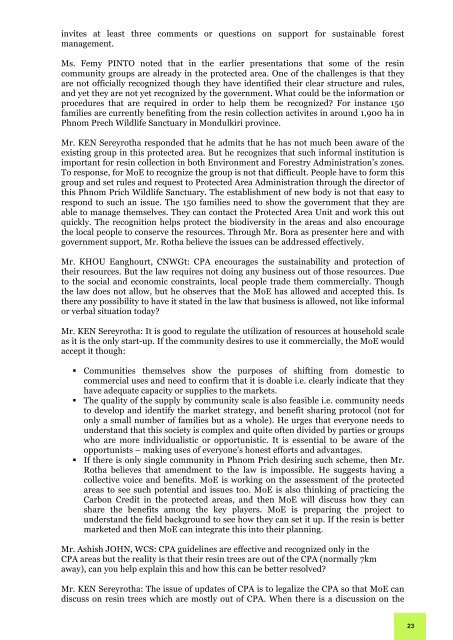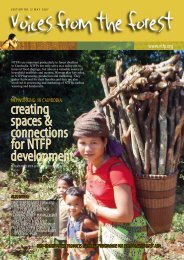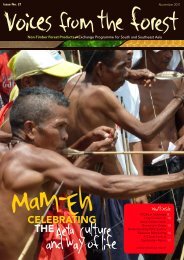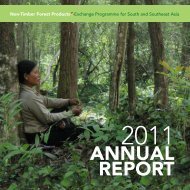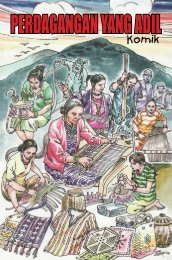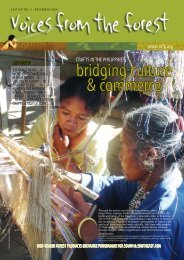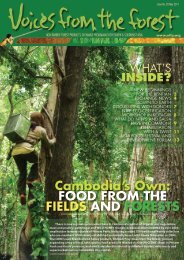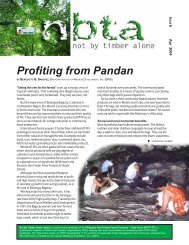Download PDF: NTFP-EP_Cambodia_Resin_Report.pdf
Download PDF: NTFP-EP_Cambodia_Resin_Report.pdf
Download PDF: NTFP-EP_Cambodia_Resin_Report.pdf
You also want an ePaper? Increase the reach of your titles
YUMPU automatically turns print PDFs into web optimized ePapers that Google loves.
invites at least three comments or questions on support for sustainable forest<br />
management.<br />
Ms. Femy PINTO noted that in the earlier presentations that some of the resin<br />
community groups are already in the protected area. One of the challenges is that they<br />
are not officially recognized though they have identified their clear structure and rules,<br />
and yet they are not yet recognized by the government. What could be the information or<br />
procedures that are required in order to help them be recognized For instance 150<br />
families are currently benefiting from the resin collection activites in around 1,900 ha in<br />
Phnom Prech Wildlife Sanctuary in Mondulkiri province.<br />
Mr. KEN Sereyrotha responded that he admits that he has not much been aware of the<br />
existing group in this protected area. But he recognizes that such informal institution is<br />
important for resin collection in both Environment and Forestry Administration’s zones.<br />
To response, for MoE to recognize the group is not that difficult. People have to form this<br />
group and set rules and request to Protected Area Administration through the director of<br />
this Phnom Prich Wildlife Sanctuary. The establishment of new body is not that easy to<br />
respond to such an issue. The 150 families need to show the government that they are<br />
able to manage themselves. They can contact the Protected Area Unit and work this out<br />
quickly. The recognition helps protect the biodiversity in the areas and also encourage<br />
the local people to conserve the resources. Through Mr. Bora as presenter here and with<br />
government support, Mr. Rotha believe the issues can be addressed effectively.<br />
Mr. KHOU Eanghourt, CNWGt: CPA encourages the sustainability and protection of<br />
their resources. But the law requires not doing any business out of those resources. Due<br />
to the social and economic constraints, local people trade them commercially. Though<br />
the law does not allow, but he observes that the MoE has allowed and accepted this. Is<br />
there any possibility to have it stated in the law that business is allowed, not like informal<br />
or verbal situation today<br />
Mr. KEN Sereyrotha: It is good to regulate the utilization of resources at household scale<br />
as it is the only start-up. If the community desires to use it commercially, the MoE would<br />
accept it though:<br />
<br />
<br />
<br />
Communities themselves show the purposes of shifting from domestic to<br />
commercial uses and need to confirm that it is doable i.e. clearly indicate that they<br />
have adequate capacity or supplies to the markets.<br />
The quality of the supply by community scale is also feasible i.e. community needs<br />
to develop and identify the market strategy, and benefit sharing protocol (not for<br />
only a small number of families but as a whole). He urges that everyone needs to<br />
understand that this society is complex and quite often divided by parties or groups<br />
who are more individualistic or opportunistic. It is essential to be aware of the<br />
opportunists – making uses of everyone’s honest efforts and advantages.<br />
If there is only single community in Phnom Prich desiring such scheme, then Mr.<br />
Rotha believes that amendment to the law is impossible. He suggests having a<br />
collective voice and benefits. MoE is working on the assessment of the protected<br />
areas to see such potential and issues too. MoE is also thinking of practicing the<br />
Carbon Credit in the protected areas, and then MoE will discuss how they can<br />
share the benefits among the key players. MoE is preparing the project to<br />
understand the field background to see how they can set it up. If the resin is better<br />
marketed and then MoE can integrate this into their planning.<br />
Mr. Ashish JOHN, WCS: CPA guidelines are effective and recognized only in the<br />
CPA areas but the reality is that their resin trees are out of the CPA (normally 7km<br />
away), can you help explain this and how this can be better resolved<br />
Mr. KEN Sereyrotha: The issue of updates of CPA is to legalize the CPA so that MoE can<br />
discuss on resin trees which are mostly out of CPA. When there is a discussion on the<br />
23<br />
23


